The handheld mesh nebulizer market is estimated at USD 221 million in 2025 and projected to reach USD 481.5 million by 2035, with a CAGR of 8.1%. The market trajectory demonstrates both steady early growth and a period of accelerated expansion, highlighting key inflection points where the pace of growth changes. From 2025 to 2028, annual revenue increments average USD 17–19 million, reflecting gradual adoption in healthcare and homecare applications. Beginning in 2029, yearly gains rise to USD 21–24 million, marking a notable inflection point driven by technological enhancements, increasing consumer awareness, and broader distribution channels. Mapping these shifts allows stakeholders to plan production scaling, investment timing, and targeted marketing strategies effectively.

| Metric | Value |
|---|---|
| Market Value (2025) | USD 221 million |
| Market Forecast Value (2035) | USD 481.5 million |
| Market Forecast CAGR (2025–2035) | 8.1% |
Between 2025 and 2028, the market grows from USD 221.0 million to USD 279.2 million, representing stable early-stage adoption and moderate market maturity. Incremental growth during this period is influenced by rising demand for portable, user-friendly respiratory devices, clinical endorsements, and moderate technological innovations. From 2029 to 2035, it rises from USD 301.8 million to USD 481.5 million, with late-period annual gains increasing from ~USD 24m to ~USD 36m, reflecting a late-stage inflection where accelerated growth is driven by broader global adoption, enhanced device functionality, and integration with digital health solutions. Recognizing these inflection points helps stakeholders optimize capacity expansion, product innovation, and strategic investment to maximize returns while sustaining long-term market momentum.
From 2029 to 2035, the market grows from USD 279.2 million to USD 481.5 million, with yearly revenue gains averaging USD 21–24 million. This phase represents a late-stage inflection where growth accelerates due to broader adoption across global markets, enhanced device functionality, and rising prevalence of respiratory disorders. Technological improvements, such as more efficient mesh nebulizer designs and integration with digital health solutions, contribute to this accelerated growth. Recognizing these late-stage inflection points helps stakeholders plan capacity expansion, launch product innovations, and capitalize on surging demand. Strategic investments timed around these growth accelerations can maximize returns while ensuring the market trajectory remains on a steady upward path through 2035.
Handheld Mesh Nebulizer Market Opportunity Pools
The Handheld Mesh Nebulizer market is entering a new phase of growth, driven by demand for portable respiratory therapy, chronic disease management expansion, and evolving patient care and technology standards. By 2035, these pathways together can unlock USD 110-145 million in incremental revenue opportunities beyond baseline growth.
Pathway A -- Asthma Management Leadership (Bronchodilator & Maintenance Therapy) The asthma segment already holds the largest share due to its widespread prevalence and critical treatment needs. Expanding clinical protocols, medication compatibility, and patient education programs can consolidate leadership. Opportunity pool: USD 35-50 million.
Pathway B -- Adult Patient Focus (Chronic Disease Management) Adult type devices account for the majority of demand. Growing adult chronic respiratory disease rates, especially in aging populations, will drive higher adoption of adult-optimized mesh nebulizers. Opportunity pool: USD 28-38 million.
Pathway C -- Home Healthcare & Patient Independence Growth Home healthcare providers and patient self-care markets are expanding, especially with chronic disease management focus. Nebulizers designed for home use (portable, easy-to-use, reliable) can capture significant growth. Opportunity pool: USD 20-28 million.
Pathway D -- Emerging Market Expansion Asia-Pacific, Middle East, and Latin America present growing demand due to rising respiratory disease awareness and healthcare accessibility. Targeting distribution networks and affordable product lines will accelerate adoption. Opportunity pool: USD 15-22 million.
Pathway E -- COPD & Cystic Fibrosis Applications With growing recognition of mesh nebulizer benefits for complex respiratory conditions, there is opportunity to develop specialized devices for COPD maintenance therapy and cystic fibrosis treatment protocols. Opportunity pool: USD 10-15 million.
Pathway F -- Pediatric & Child-Specific Solutions Child type nebulizers with age-appropriate features, attractive designs, and pediatric-optimized medication delivery offer growth positioning for pediatric respiratory care markets. Opportunity pool: USD 8-12 million.
Pathway G -- Connected Health & Digital Integration Nebulizers with smartphone connectivity, medication tracking, and adherence monitoring create premium value propositions for chronic disease management programs. Opportunity pool: USD 5-8 million.
Pathway H -- Clinical Services & Patient Support Comprehensive patient training, clinical support programs, and medication optimization services create recurring value streams beyond device sales. Opportunity pool: USD 3-5 million.
Why is the Handheld Mesh Nebulizer Market Growing?
Market expansion is being supported by the rapid increase in chronic respiratory disease prevalence worldwide and the corresponding need for efficient drug delivery devices that provide superior medication nebulization performance and patient mobility. Modern respiratory care relies on consistent medication delivery quality and treatment accessibility to ensure optimal therapeutic outcomes including asthma management, COPD treatment, and cystic fibrosis care. Even minor medication delivery inefficiencies can require comprehensive treatment protocol adjustments to maintain optimal patient outcomes and disease management.
The growing complexity of respiratory therapy requirements and increasing demand for patient-centered care solutions are driving demand for handheld mesh nebulizer devices from certified manufacturers with appropriate clinical capabilities and regulatory expertise. Healthcare providers are increasingly requiring documented medication delivery efficiency and device reliability to maintain treatment quality and patient compliance. Clinical specifications and therapeutic standards are establishing standardized nebulization procedures that require specialized mesh technology and trained healthcare professionals.
The market is segmented by nebulizer type, application, and region. By nebulizer type, the market is divided into adult type and child type. Based on application, the market is categorized into asthma, COPD, cystic fibrosis, and others. Regionally, the market is divided into North America, Europe, East Asia, South Asia & Pacific, Latin America, and Middle East & Africa.
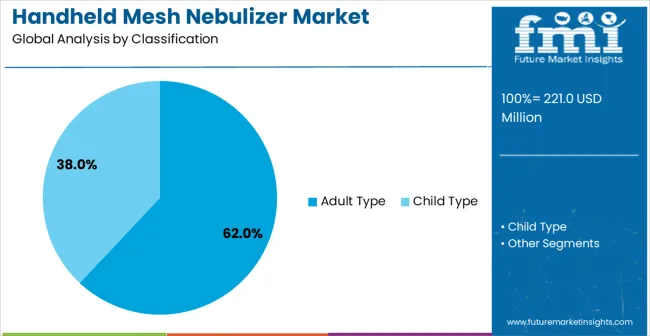
The adult type handheld mesh nebulizer segment is projected to capture 62% of the market share in 2025, maintaining its leading position. This dominance is driven by the widespread use of adult-focused nebulization devices, which address higher prevalence of chronic respiratory conditions in adult populations. Adult nebulizers provide optimized particle size distribution, appropriate flow rates, and effective medication delivery tailored for adult respiratory anatomy, ensuring therapeutic efficiency across diverse clinical scenarios.
Hospitals, respiratory clinics, home healthcare providers, and adult patients prefer these devices for their ease of use, reliability, and low maintenance requirements. Advanced product designs, clinical validation, and robust technical support from manufacturers reinforce the segment’s market position. Consistent global demand, driven by the largest patient population needing respiratory therapy, further strengthens adult nebulizers’ dominance. The combination of clinical effectiveness, therapeutic reliability, and patient suitability ensures continued adoption in both institutional and homecare settings.
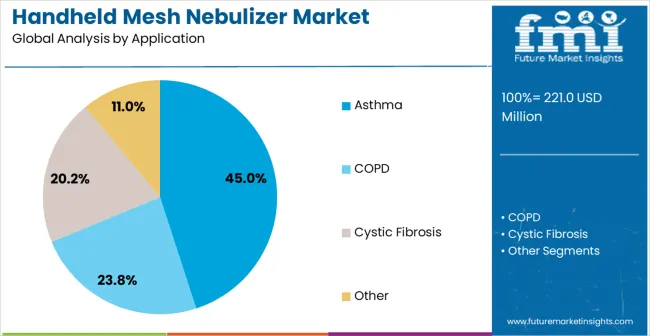
The asthma segment is expected to account for 45% of handheld mesh nebulizer demand in 2025, remaining the largest application sector. This dominance is driven by the global prevalence of asthma and the critical need for effective bronchodilator and corticosteroid delivery. Asthma patients require frequent and reliable medication administration that reaches the lower respiratory tract efficiently, making portable nebulizers particularly suitable for both maintenance and acute therapy.
The segment benefits from increased awareness of self-management programs and patient mobility solutions. Healthcare providers emphasize consistent, fine-particle aerosol delivery to optimize treatment outcomes. Rising asthma incidence and the push for personalized care strategies drive continuous demand for handheld mesh nebulizers. Regulatory focus on patient adherence, quality of care, and accessibility further strengthens market growth. These devices provide essential capabilities for effective symptom control, patient independence, and improved quality of life, ensuring the asthma segment remains a stable, long-term demand driver.
The Handheld Mesh Nebulizer market is advancing steadily due to increasing prevalence of respiratory diseases and growing recognition of mesh nebulization technology advantages over traditional jet nebulizers. However, the market faces challenges including higher device costs compared to conventional nebulizers, need for proper maintenance and cleaning procedures, and varying reimbursement policies across different healthcare systems. Clinical validation efforts and technology advancement programs continue to influence device development and market adoption patterns.
The growing development of advanced mesh nebulization systems is enabling superior medication delivery with improved particle size consistency and reduced medication waste characteristics. Enhanced mesh technologies and optimized aerosol generation provide effective drug delivery while maintaining device reliability requirements. These technologies are particularly valuable for respiratory care providers who require consistent therapeutic performance that can support diverse patient treatment needs with reliable medication delivery results.
Modern handheld mesh nebulizer manufacturers are incorporating advanced connectivity features and digital monitoring capabilities that enhance patient compliance and treatment effectiveness. Integration of advanced usage tracking systems and optimized medication delivery monitoring enables superior therapy management and comprehensive treatment adherence capabilities. Advanced connectivity features support use in diverse care environments while meeting various clinical requirements and patient monitoring specifications.
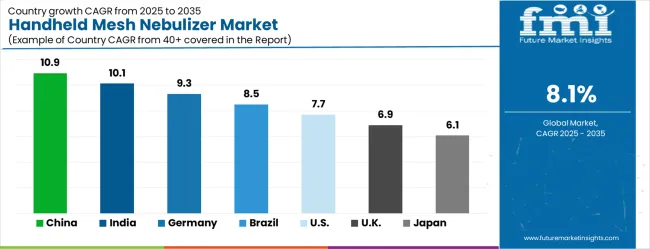
| Country | CAGR (2025–2035) |
|---|---|
| China | 10.9% |
| India | 10.1% |
| Germany | 9.3% |
| Brazil | 8.5% |
| United States | 7.7% |
| United Kingdom | 6.9% |
| Japan | 6.1% |
The handheld mesh nebulizer market is growing rapidly, with China leading at a 10.9% CAGR through 2035, driven by strong healthcare infrastructure development and increasing adoption of advanced respiratory therapy devices. India follows at 10.1%, supported by rising respiratory disease prevalence and growing awareness of portable nebulization solutions. Germany grows steadily at 9.3%, integrating mesh nebulizer technology into its established respiratory care infrastructure. Brazil records 8.5%, emphasizing healthcare modernization and chronic disease management initiatives. The United States shows solid growth at 7.7%, focusing on patient-centered care enhancement and therapeutic innovation. The United Kingdom demonstrates steady progress at 6.9%, maintaining established respiratory therapy applications. Japan records 6.1% growth, concentrating on technology advancement and clinical precision optimization.
The report covers an in-depth analysis of 40+ countries top-performing countries are highlighted below.
The handheld mesh nebulizer market in China is projected to grow at a CAGR of 10.9% through 2035, driven by rapid expansion of respiratory care infrastructure and rising demand for portable therapeutic devices. Hospitals and medical centers are increasingly adopting advanced mesh nebulizers to support chronic disease management programs, with major manufacturers establishing distribution networks across urban healthcare hubs. Government healthcare modernization initiatives and patient-centered care programs are further stimulating adoption. Competitive pressures from India and Germany are accelerating innovation in device reliability, patient convenience, and operational efficiency. Investments in clinical training and workflow integration are enhancing utilization of mesh nebulizers across healthcare facilities, enabling improved treatment outcomes and standardized respiratory therapy protocols nationwide.
The handheld mesh nebulizer market in India is expected to grow at a CAGR of 10.1% through 2035, supported by increasing respiratory disease prevalence and rising awareness of advanced nebulization benefits. Hospitals and respiratory clinics are gradually implementing professional-grade mesh nebulizers to ensure consistent treatment outcomes. Expanding healthcare infrastructure and modernization programs are driving adoption of portable therapeutic solutions. Competitive dynamics with China and Germany are fostering innovation in device reliability, portability, and cost efficiency. Professional training initiatives are enhancing clinical expertise among respiratory therapists, enabling effective device utilization and standardized patient care. Investments in respiratory care programs and chronic disease management initiatives are further supporting mesh nebulizer integration across medical facilities nationwide.
The handheld mesh nebulizer market in Germany is projected to grow at a CAGR of 9.3% through 2035, driven by high standards in respiratory care and advanced therapeutic technology adoption. German hospitals and specialized respiratory care centers are implementing mesh nebulizers that meet strict clinical requirements and patient safety protocols. Competitive pressures from China and India encourage development of devices with superior reliability, therapeutic precision, and patient comfort. Investments in professional certification and clinical training programs are enabling healthcare providers to optimize therapy outcomes. National healthcare modernization initiatives and technology adoption programs are stimulating integration of mesh nebulizers across facilities, supporting consistent respiratory care standards, treatment effectiveness, and clinical workflow efficiency throughout the country.
The handheld mesh nebulizer market in Brazil is expected to grow at a CAGR of 8.5% through 2035, driven by increasing healthcare facility development and recognition of portable respiratory therapy advantages. Medical centers and respiratory clinics are adopting professional-grade mesh nebulizers to improve patient treatment outcomes and accessibility. Expansion of healthcare infrastructure and modernization programs is stimulating device adoption. Competitive pressures from China and India are encouraging innovation in device performance, durability, and clinical usability. Professional development initiatives are enhancing clinical capabilities among healthcare providers, enabling effective mesh nebulizer utilization. National respiratory care initiatives and chronic disease management programs are supporting consistent treatment protocols and integration of advanced nebulization technology across Brazilian medical establishments.

The handheld mesh nebulizer market in the United States is projected to grow at a CAGR of 7.7% through 2035, driven by established respiratory care systems and rising emphasis on patient convenience. Hospitals and respiratory therapy providers are implementing mesh nebulizers to standardize treatment workflows and improve clinical outcomes. Competitive pressures from Germany and China are accelerating adoption of portable, efficient, and reliable devices. Professional development and certification programs are enhancing clinical expertise among respiratory therapists, enabling optimal utilization of mesh nebulizer technology. Investments in patient-centered care initiatives, workflow integration, and chronic disease management programs are supporting mesh nebulizer adoption across healthcare networks, ensuring consistent therapy quality, compliance with clinical standards, and improved accessibility of respiratory care services.
The handheld mesh nebulizer market in the United Kingdom is expected to grow at a CAGR of 6.9% through 2035, supported by established healthcare systems and growing adoption of portable respiratory therapy solutions. British hospitals and respiratory care providers are integrating mesh nebulizers that meet clinical quality standards and treatment requirements. Competitive dynamics with Germany and the USA are fostering innovation in portability, precision, and device reliability. Professional development programs are improving clinical expertise among healthcare personnel, enabling effective use of handheld nebulizers. Investments in facility upgrades, respiratory care programs, and chronic disease management initiatives are further supporting adoption of advanced mesh nebulizers, ensuring consistent therapeutic outcomes, regulatory compliance, and patient-centered respiratory care across the UK
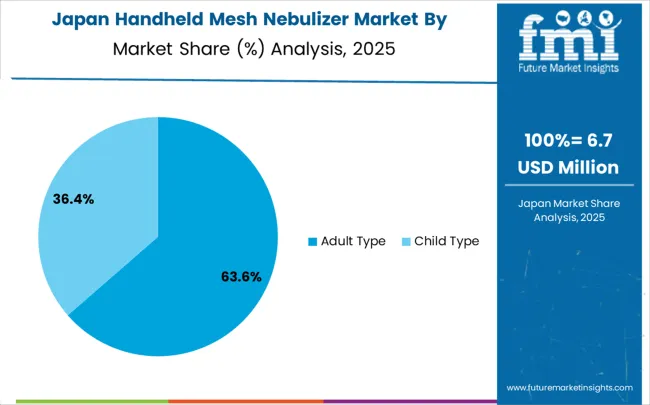
The handheld mesh nebulizer market in Japan is projected to grow at a CAGR of 6.1% through 2035, driven by technology innovation and clinical precision enhancement initiatives. Japanese healthcare institutions are adopting advanced mesh nebulizers to improve therapeutic reliability and patient outcomes. Competitive pressures from China and Germany are encouraging development of devices with superior precision, efficiency, and operational consistency. Investments in professional development programs are enhancing technical expertise among respiratory therapists, enabling specialized therapy capabilities. Technology adoption programs and national respiratory care initiatives are promoting widespread integration of handheld mesh nebulizers, ensuring optimized clinical workflows, enhanced patient convenience, and adherence to Japanese healthcare quality standards across hospitals and specialized respiratory care centers.
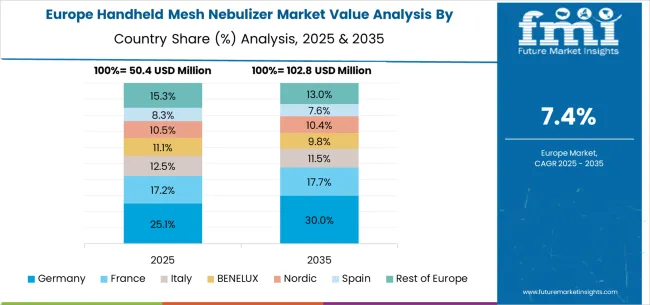
The handheld mesh nebulizer market in Europe is forecast to expand from USD 59.2 million in 2025 to USD 128.4 million by 2035, registering a CAGR of 8.0%. Germany will remain the largest market, holding 29.0% share in 2025, easing to 28.5% by 2035, supported by strong respiratory care infrastructure and advanced therapeutic systems. The United Kingdom follows, rising from 22.0% in 2025 to 22.5% by 2035, driven by healthcare institutions and chronic disease management initiatives. France is expected to decline slightly from 18.0% to 17.5%, reflecting healthcare budget constraints. Italy maintains stability at around 15.0%, supported by respiratory clinics and patient care centers, while Spain grows from 11.0% to 11.5% with expanding healthcare and respiratory therapy demand. BENELUX markets ease from 3.5% to 3.4%, while the remainder of Europe hovers near 1.5%--1.6%, balancing emerging Eastern European growth against mature Nordic markets.
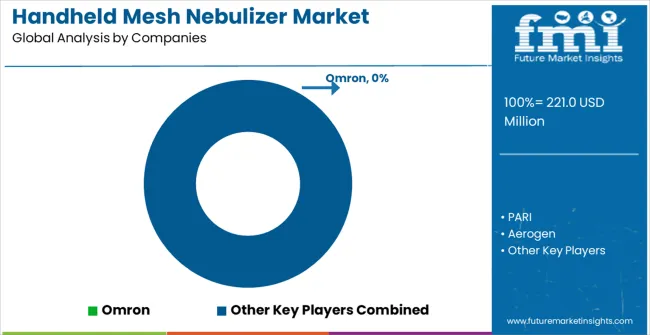
Competition in the handheld mesh nebulizer market is dominated by specialized medical device manufacturers, respiratory therapy providers, and technology-driven healthcare companies. Omron supplies comprehensive mesh nebulizer systems, emphasizing reliability, ease of use, and trusted medical device performance. PARI delivers respiratory care equipment designed for clinical accuracy and consistent therapeutic outcomes. Aerogen focuses on hospital-grade aerosol delivery solutions, validated for professional care settings. Philips provides integrated respiratory devices with attention to usability and seamless adoption in healthcare environments.
Market positioning is influenced by device portability, innovative mesh technologies, and patient-centric design. Medel International offers professional respiratory solutions with extensive patient support services. Chinavi applies advanced mesh technology to ensure uniform nebulization and dependable performance. Yuwell develops user-friendly devices with focus on accessibility, convenience, and home use. Honsun, Cofoe Medical, VAPO Healthcare, BMC Medical, and SIMZO contribute specialized manufacturing capabilities, reliability, and product development expertise for global and regional healthcare segments.
Product literature emphasizes aerosol delivery efficiency, ease of handling, maintenance simplicity, and clinical effectiveness. Compact and lightweight designs are highlighted to improve patient adherence and portability. Performance data, therapeutic reliability, and user interface features are showcased to demonstrate operational advantages. Technical specifications, validated clinical studies, and ergonomic design elements are presented to reinforce trustworthiness and functionality. Each brochure serves as a clear representation of device capabilities, market differentiation, and strategic value, collectively illustrating the competitive landscape and innovation-driven strategies in the handheld mesh nebulizer market.
| Item | Value |
|---|---|
| Quantitative Units | USD million |
| Nebulizer Type | Adult Type, Child Type |
| Application | Asthma, COPD, Cystic Fibrosis, Others |
| Regions Covered | North America, Europe, East Asia, South Asia & Pacific, Latin America, Middle East & Africa |
| Country Covered | China, India, Germany, Brazil, United States, United Kingdom, Japan, and 40+ countries |
| Key Companies Profiled | Omron, PARI, Aerogen, Philips, Medel International, Chinavi, Yuwell, Honsun, Cofoe Medical, VAPO Healthcare, BMC Medical, SIMZO, Beurer, Drive DeVilbiss Healthcare, Rossmax International |
| Additional Attributes | Dollar sales by nebulizer type and application segment, regional demand trends across major markets, competitive landscape with established respiratory care device manufacturers and emerging nebulization technology providers, customer preferences for different device types and therapeutic applications, integration with respiratory care protocols and chronic disease management systems, innovations in mesh nebulization efficiency and portable design technologies, and adoption of smart connectivity features with enhanced patient compliance capabilities for improved therapeutic workflows. |
The global handheld mesh nebulizer market is estimated to be valued at USD 221.0 million in 2025.
The market size for the handheld mesh nebulizer market is projected to reach USD 481.5 million by 2035.
The handheld mesh nebulizer market is expected to grow at a 8.1% CAGR between 2025 and 2035.
The key product types in handheld mesh nebulizer market are adult type and child type.
In terms of application, asthma segment to command 45.0% share in the handheld mesh nebulizer market in 2025.






Full Research Suite comprises of:
Market outlook & trends analysis
Interviews & case studies
Strategic recommendations
Vendor profiles & capabilities analysis
5-year forecasts
8 regions and 60+ country-level data splits
Market segment data splits
12 months of continuous data updates
DELIVERED AS:
PDF EXCEL ONLINE
Handheld Electrostatic Meter Market Size and Share Forecast Outlook 2025 to 2035
Handheld Ultrasound Scanner Market Size and Share Forecast Outlook 2025 to 2035
Handheld Tagging Gun Market Forecast and Outlook 2025 to 2035
Handheld Imaging Systems Market Size and Share Forecast Outlook 2025 to 2035
Handheld XRF Analyzers Market Size and Share Forecast Outlook 2025 to 2035
Handheld Police Radar Guns Market Size and Share Forecast Outlook 2025 to 2035
Handheld DNA Reader Market Size and Share Forecast Outlook 2025 to 2035
Handheld Robotic Navigation Market Analysis - Size, Share, and Forecast Outlook 2025 to 2035
Handheld Chemical and Metal Detector Market Size and Share Forecast Outlook 2025 to 2035
Handheld Dental X-Ray Systems Market Analysis - Size, Share, and Forecast 2025 to 2035
Handheld Concrete Saws Market Size and Share Forecast Outlook 2025 to 2035
Handheld Point of Sale Market Analysis - Size, Share, and Forecast Outlook 2025 to 2035
Handheld Arthroscopic Instruments Market Growth – Trends & Forecast 2025 to 2035
Handheld Marijuana Vaporizer Market Insights – Demand & Forecast 2025-2035
Handheld Device Accessories Market
Handheld GPS Units Market
Handheld Retinal Scanners Market
Handheld DC Torque Tools Market
Rugged Handheld Electronic Devices Market Analysis – Size, Share & Forecast 2025 to 2035
Wireless Handheld Spectrometer Market

Thank you!
You will receive an email from our Business Development Manager. Please be sure to check your SPAM/JUNK folder too.
Chat With
MaRIA